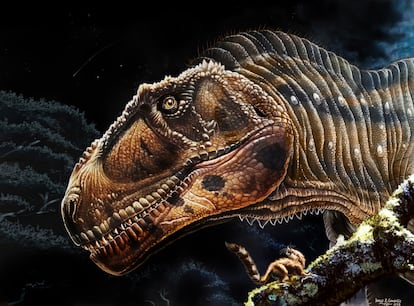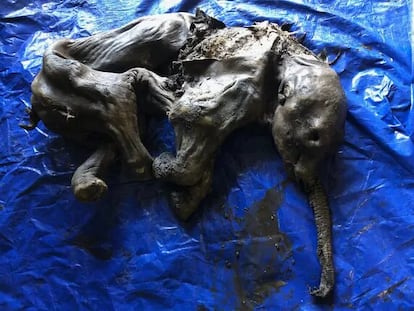‘Meraxes gigas’: New species of giant dinosaur discovered in Argentina
The 93-million-year-old carnivore was named after a dragon from the literary saga that inspired the popular TV series ‘Game of Thrones’

Argentine, American, and Canadian paleontologists just announced a new species of giant carnivorous dinosaur – Meraxes gigas – first unearthed in 2012 in Neuquén, a province in Argentina’s Patagonia region. The first complete scientific study of this species has now been published in Current Biology, a journal that publishes original research across all areas of biology.
The species is a carcharondontosaurid theropod dinosaur, the largest predators from the Cretaceous age (90-100 million years ago). Like all theropods, they were short-armed and light-boned bipeds. Members of this particular family of dinosaurs were the longest of the theropods, measuring about 40 feet (12-13 meters) from snout to tail. One of its most distinctive features were its sharply serrated and curved teeth that resembled four-inch pruning saws (Carcharodontosaurus means shark-toothed lizard in Greek). Weighing more than four tons, “the great dinosaur eater,” as the press release from the National University of Río Negro dubbed it, was once one of the largest carnivorous lizards in South America.
Paleontologist Juan Ignacio Canale, a researcher with Argentina’s National Council for Scientific and Technical Research (CONICET) and the National University of Río Negro, is the lead author of the Current Biology article. In a video interview from wintry Patagonia, Canale said it reminded him of one particular dragon. “I came up with the name because I love A Song of Ice and Fire,” the series of epic fantasy novels that inspired the hit Game of Thrones TV series. “I love the names George R. R. Martin chose for his dragons, and this one [Meraxes] fit perfectly because both are very large reptiles with giant skulls. We also needed a new name to distinguish Meraxes from two other giant carcharodontosaurs found in Neuquén: Giganotosaurus carolinii – the ‘villain’ from the last Jurassic World movie – and Mapusaurus. This is the third of its kind, like the three dragons from A Song of Ice and Fire,” said Canale.
Ten years of research funded by the municipality of El Chocón (the fossil-rich town in Neuquén), National Geographic, and the Field Museum in Chicago (USA) preceded this dramatic announcement. Unearthing the dinosaur went quickly in comparison. On the first day of fieldwork, they spotted an exposed spinal vertebra. “We started digging and more and more bones appeared. We were shocked,” said Canale. “We found a skull with no mandible, but with an intact maxilla and some teeth.” They were actually incipient teeth because unlike humans, dinosaurs and crocodiles produce several generations of teeth throughout their lives. The Neuquén Meraxes was 45 years old when it perished, making it one of the oldest carnivorous dinosaurs to be discovered.
Almost all of the arm and leg bones were found intact, “which is very unusual because in general, not much remained of the legs and arms of the largest carcharodontosaurs discovered from the Middle to Late Cretaceous period,” said Canale. This enabled the research team to identify a new and distinctive feature of this species – a powerful claw on the inner toe that is much larger and sharper than the other two.

The hips are also distinctive. Spines on the dinosaur’s back project upward above the waist and are reminiscent of the hump on the Concavenator, discovered in 2015 in Cuenca (Spain). Making another nod to the literary inspiration for the dinosaur’s name, the press release describes this part of the dinosaur as “Queen Rhaenys Targaryen’s saddle,” after the dragon mounted by the fictional queen.
The skull is another excellent specimen. Besides being enormous, it is the most complete example found so far and exhibits intricate bones with protuberances, ridges, and grooves. It provided the researchers with valuable information not only about Meraxes, but about all the species of the family, including the famous Gigantosaurus.
“It provided a lot of information about their anatomy,” said Canale. “We observed that the arms were very short, something that we previously suspected, but can now say for certain since we have actual measurements.” The analysis concluded that, like other known groups of carnivores such as the Tyrannosaurus and the Abelisaurus, the arms became shorter over time until they were only 40% of the femur’s size. Then they stopped shrinking and no one knows why. “The question is why did they reach that limit? Why didn’t the arms keep shrinking? The proportion of the arms to the femur is similar in all of these species,” said Canale. Like many scientific endeavors, some answers just raise more questions.
The research team tested various hypotheses. “We observed that the pectoral girdle, which is where the arm, scapula, and other bones are inserted, is not small where the arm fits in. It’s a very large and well-developed bone that encapsulates a lot of the musculature that extends to the extremities. Since that musculature has to fit in somewhere, perhaps this is the reason why the arms didn’t shrink any further. All the musculature that originated in the scapula had to be inserted somewhere.” The usefulness of such short limbs is still a matter of controversy. Some speculate that they served for support during copulation, for tearing apart prey, or simply to avoid hitting the ground. But arm size does not seem so important when you have a huge skull. The skull of Meraxes gigas was a little over four feet (1.27 meters) long. Other Carcharodontosaurus also had large heads, such as the Tyrannosaurus rex (4.6 feet or 1.40 meters) and the Giganotosaurus carolinii (5.3 feet or 1.63 meters). “Things that other carnivorous hunters did with their arms, these dinosaurs could do with their heads – seize and manipulate prey, pin it to the ground, and kill it,” said Canale. Therefore, the arms would not have been very useful for eating, especially when they tried to devour other giants like the Argentinosaurus, one of the largest herbivores in the history of the planet. “Surely, it’s no coincidence that carnivores and the larger herbivores coexisted. There is probably a food chain relationship. It’s like an arms race: the prey grows larger as a defense mechanism, and their predators also grow to be able to hunt them,” said the paleontologist.
By looking at other coexisting species, scientists can theorize about the evolutionary end of the carcharodontosaurus family of dinosaurs. Specimens of two other species – Mapusaurus and Taurovenator – from the same geological period (93-96 million years ago) have been discovered. “This leads us to posit that before becoming extinct, they reached a peak level of diversification. It was a group that diversified a great deal just before its extinction. That’s when they died out and were no longer the top terrestrial predators of their time in South America.” Later, they would be succeeded by the abelisaurids and the megaraptors, but that’s another story.
The team of scientists includes Sebastián Apesteguía, Pablo Gallina, Alejandro Haluza and Federico Gianechini from Argentina; Jonathan Mitchell, Nathan Smith, Akiko Shinya, and Peter Macovicky from the United States; and Thomas Cullen from Canada. The team plans to continue its research using more sophisticated techniques such as CT scans and detailed reconstructions, as it searches for more answers about the bones, muscles, and general anatomy of the “Ice and Fire” dragon.
Tu suscripción se está usando en otro dispositivo
¿Quieres añadir otro usuario a tu suscripción?
Si continúas leyendo en este dispositivo, no se podrá leer en el otro.
FlechaTu suscripción se está usando en otro dispositivo y solo puedes acceder a EL PAÍS desde un dispositivo a la vez.
Si quieres compartir tu cuenta, cambia tu suscripción a la modalidad Premium, así podrás añadir otro usuario. Cada uno accederá con su propia cuenta de email, lo que os permitirá personalizar vuestra experiencia en EL PAÍS.
¿Tienes una suscripción de empresa? Accede aquí para contratar más cuentas.
En el caso de no saber quién está usando tu cuenta, te recomendamos cambiar tu contraseña aquí.
Si decides continuar compartiendo tu cuenta, este mensaje se mostrará en tu dispositivo y en el de la otra persona que está usando tu cuenta de forma indefinida, afectando a tu experiencia de lectura. Puedes consultar aquí los términos y condiciones de la suscripción digital.
More information
Últimas noticias
Most viewed
- Reinhard Genzel, Nobel laureate in physics: ‘One-minute videos will never give you the truth’
- Oona Chaplin: ‘I told James Cameron that I was living in a treehouse and starting a permaculture project with a friend’
- Pablo Escobar’s hippos: A serious environmental problem, 40 years on
- Why we lost the habit of sleeping in two segments and how that changed our sense of time
- Chevy Chase, the beloved comedian who was a monster off camera: ‘Not everyone hated him, just the people who’ve worked with him’









































